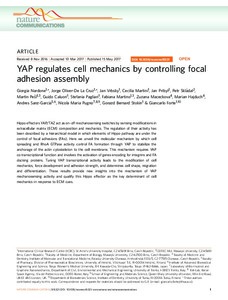YAP regulates cell mechanics by controlling focal adhesion assembly
Giorgia Nardone; Jorge Oliver-De La Cruz; Jan Vrbsky; Cecilia Martini; Jan Pribyl; Petr Skla´dal; Martin Pes; Guido Caluori; Stefania Pagliari; Fabiana Martino; Zuzana Maceckova; Marian Hajduch; Andres Sanz-Garcia; Nicola Maria Pugno; Gorazd Bernard Stokin; Giancarlo Forte
https://urn.fi/URN:NBN:fi-fe2021042718805
Tiivistelmä
Hippo effectors YAP/TAZ act as on–off mechanosensing switches by sensing modifications in
extracellular matrix (ECM) composition and mechanics. The regulation of their activity has
been described by a hierarchical model in which elements of Hippo pathway are under the
control of focal adhesions (FAs). Here we unveil the molecular mechanism by which cell
spreading and RhoA GTPase activity control FA formation through YAP to stabilize the
anchorage of the actin cytoskeleton to the cell membrane. This mechanism requires YAP
co-transcriptional function and involves the activation of genes encoding for integrins and FA
docking proteins. Tuning YAP transcriptional activity leads to the modification of cell
mechanics, force development and adhesion strength, and determines cell shape, migration
and differentiation. These results provide new insights into the mechanism of YAP
mechanosensing activity and qualify this Hippo effector as the key determinant of cell
mechanics in response to ECM cues.
Kokoelmat
- Rinnakkaistallenteet [27094]
